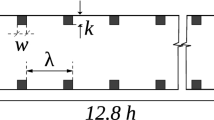Abstract
The local pressure distributions and resistance coefficients (f 1 andf 2) through the sharp 180 deg turn in a relatively short (L/D e=4) two-pass smooth and rib-roughened channel were investigated for a Reynolds number range of 1.0×103−9.0×103. The rib pitch-to-height ratios (p/e) were 5,10, and 20. The rib height-to-hydraulic diameter ratios (e/D e) were 0.025, 0.050 and 0.10, and the rib angles of attack (α) were 90, 45, 60, −45, and −60 deg. Ribs were installed not only in before and after turn regions but also in turn region. The results show that the resistance coefficients remain approximately constant when Reynolds number is more than 3.0×104. The effects of the rib configuration (rib spacing, rib height, and rib orientation) on the inlet straight duct resistance coefficient (f 2) were significant, however, their effects on the overall resistance coefficient (f 1) were diluted by the sharp-180 turn. For this relatively short channel (L/D e=4), the overall resistance coefficient (f 1) was greatly affected by the sharp turn. Correlations for the overall resistance (f 1) and inlet straight duct resistance coefficient (f 2) are presented.
Similar content being viewed by others
References
Han, J.C., “Heat Transfer and Friction in Channels with Two Opposite Rib-Roughened Walls,”ASME Journal of Heat Transfer,106, pp.774–781, (1984).
Han, J.C., Park, J.S. and Lei, C.K., “Heat Transfer Enhancement in Channels with Turbulence Promoters,”ASME Journal of Engineering for Gas Turbines and Power,107, pp.628–635, (1985).
Han, J.C., and Park, J.S., “Developing Heat Transfer in Rectangular Channels with Rib Turbulators,”International Journal of Heat and Mass Transfer,31, No.1, pp.183–195, (1988).
Metzger, D.E., Plevich, C.W. and Fan, C.S., “Pressure Loss Through Sharp 180 deg Turns in Smooth Rectangular Channels,”ASME Journal of Engineering for Gas Turbines and Power,106, pp.677–681, (1984).
Metzger, D.E. and Sahm, M.K., “Heat Transfer Around Sharp 180-deg Turns in Smooth Rectangular Channels,”ASME Journal of Heat Transfer,108, pp.500–506, (1986).
Chyu, M.K., “Regional Heat Transfer in Two-Pass and Three-Pass with 180-deg Sharp Turns,”ASME Journal of Heat Transfer,113, pp.65–70, (1991).
Boyle, R.J., “Heat Transfer in Serpentine Passages with Turbulence Promoters,” ASME paper, No.84-HT-24, (1984).
Han, J.C. and Chandra, P.R., “Local Heat/Mass Transfer and Pressure Drop in a Two-Pass Rib-Roughened Channel for Turbine Airfoil Cooling,” NASA CR-179635; AVSCOM TR-87-C-14, (1987).
Han, J.C. and Zhang, P., “Pressure Loss Distribution in Three-Pass Rectangular Channels with Rib Turbulators,”ASME Journal of Turbomachinery,111, pp.515–521, (1989).
Kline, S.J. and McClintock, F.A., “Describing Uncertainties in Single-Sample Experiments,”Mechanical Engineering,75, pp.3–8, (1953).
Author information
Authors and Affiliations
Rights and permissions
About this article
Cite this article
Zhao, C.Y., Tao, W.Q. Pressure loss through sharp 180 deg turn in a relatively short two-pass smooth and rib-roughened channel. J. of Thermal Science 4, 109–116 (1995). https://doi.org/10.1007/BF02653194
Issue Date:
DOI: https://doi.org/10.1007/BF02653194



